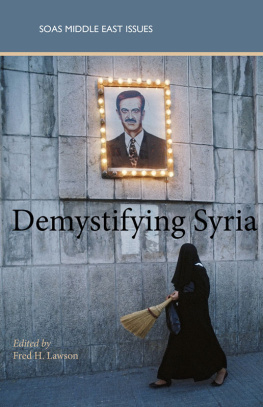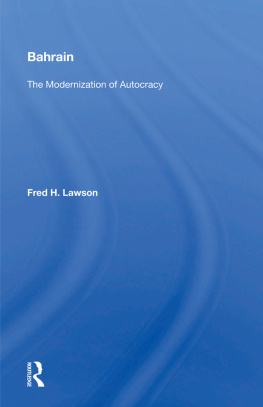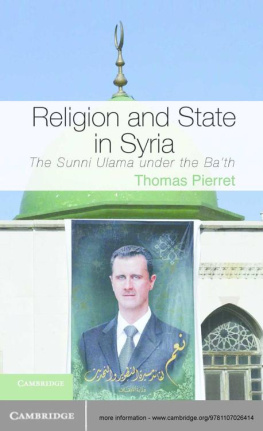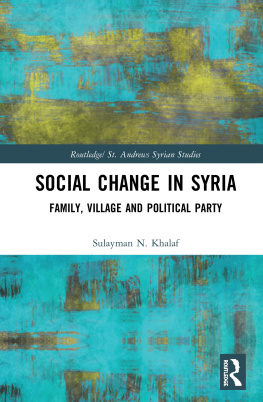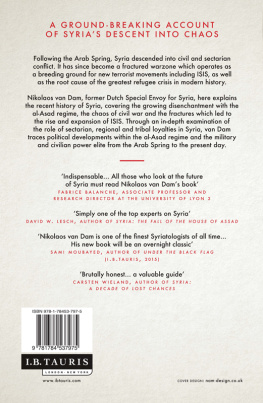SOAS MIDDLE EAST ISSUES
Demystifying Syria
Edited by
Fred H. Lawson
SAQI
in association with
eISBN: 978-0-86356-818-3
London Middle East Institute at SOAS, 2009 and 2012
First published by Saqi, 2009
This eBook edition published 2012
All rights reserved. No part of this book may be reproduced or transmitted in any form or by any means, electronic or mechanical, including photocopying, recording or by any information storage and retrieval system, without permission in writing from the publisher.
This book is sold subject to the condition that it shall not, by way of trade or otherwise, be lent, re-sold, hired out, or otherwise circulated without the publishers prior consent in any form of binding or cover other than that in which it is published and without a similar condition including this condition being imposed on the subsequent purchaser.
A full CIP record for this book is available from the British Library.
A full CIP record for this book is available from the Library of Congress.
SAQI
26 Westbourne Grove, London W2 5RH
www.saqibooks.com
in association with
The London Middle East Institute
School of Oriental and African Studies, Russell Square, London WC1H OXG
www.lmei.soas.ac.uk
Contents
Salwa Ismail
2. Enduring Legacies:
The politics of private sector development in Syria
Bassam Haddad
Zohair Ghazzal, Baudouin Dupret and Souhail Belhadj
Thomas Pierret
5. The Shii Mausoleums of Raqqa:
Iranian proselytism and local significations
Myriam Ababsa
6. The 2004 Events in al-Qamishli:
Has the Kurdish question erupted in Syria?
Julie Gauthier
7. The Syrian Opposition:
The struggle for unity and relevance, 20032008
Joe Pace and Joshua Landis
8. Partnership with the European Union:
Hopes, risks and challenges for the Syrian economy
Anja Zorob
Bassel F. Salloukh
10. The Beginning of a Beautiful Friendship:
SyrianTurkish relations since 1998
Fred H. Lawson
Acknowledgements
Julie Gauthiers essay originally appeared as Les evenements de Qamichlo: irruption de la question kurde en Syrie in the May 2005 issue of tudes Kurdes: Revue Semestrielle de Recherches, published by Editions LHarmattan in Paris. It is translated and republished here by permission of the editor of that journal.
Louise Hosking of the London Middle East Institute copyedited the manuscript with exceptional skill and insight, and with persistent good humour. The editor and contributors are deeply in her debt.
Introduction
Fred H. Lawson
Syrias political, economic, social and diplomatic affairs are often described as mysterious, puzzling or strange. Sometimes, the descriptions seem apt. At least for now, the October 2005 death of Minister of the Interior Ghazi Kanan remains a mystery, as does the killing of General Muhammad Sulaiman at his beachfront chalet in early August 2008.1 Equally mysterious at this point is the rapid and unexpected eclipse of General Asif Shawkat, the brother-in-law of the president and head of one of the countrys powerful security services.2 And it is fair to say that mystery surrounded a powerful car bomb explosion that ripped through a residential neighbourhood on the outskirts of Damascus [at the end of September 2008], killing at least seventeen people and injuring fourteen in the deadliest terrorist attack in Syria in more than two decades.3 The location of the blast, just outside the headquarters of one of the security services, and at a busy crossroads leading to the Shii pilgrimage site of the tomb of al-Sayyidah Zainab, leaves one wondering whether the intended target was the military post or the Lebanese, Iraqi and Iranian pilgrims who frequent the area.
Other so-called mysteries reflect a lack of information or superficial analysis. It is probably not helpful to conclude, for instance, that an armed skirmish between Islamist militants and security personnel that erupted in the heart of the capital in June 2006 remains shrouded in mystery, despite a flood of rumours surrounding the episode.4 It is almost certainly misleading to think of the alliance of Syria, Iran, Hizbullah and Hamas as strange [and] unnatural,5 simply because it brings together unlikely bedfellows. And asserting that Syrias reluctance to engage in public discussions with Israel after an eight-year hiatus, which Damascus blames on inflexibility and high-handedness on the part of the Israeli and the United States leaderships, illustrates the political and military murkiness of Syrian diplomacy is patently unfair.6
Perhaps there are underlying reasons why unsympathetic observers would characterise any given country as mysterious, puzzling or strange. Western liberal thought exhibits a tendency to interpret actions and platforms that do not conform to its own basic tenets as irrational or inexplicable, and this inclination lies at the heart of a good deal of United States foreign policy.7 There may even be good reasons for astute players to shroud their actions and platforms in a cloak of mysteriousness: one of the more intriguing social movements in contemporary Syria actually calls itself The Strange Ones (ghuraba al-sham), perhaps in order to keep the authorities guessing about its true intentions and programme.
But for anyone who wishes to understand todays Syria, referring to developments in domestic and foreign affairs as mysterious and puzzling is a clarion call to exert greater effort to unravel the mysteries and solve the puzzles. The contributors to this collection of essays have been energised, rather than confounded, by the complexities, uncertainties and paradoxes that characterise Syrias internal and external affairs. They offer insight into a wide range of current trends, sometimes by analysing this particular case in terms of broader theories and debates in the social sciences and sometimes by presenting information that is generally overlooked or unreported. Readers will come away knowing much more about this pivotal country than they did when they first opened the book and can be expected to gain a clearer understanding of the political, economic, social and diplomatic dynamics that shape one of the few countries that continues to resist the end of history.
Notes
1. Syrian Interior Minister Commits Suicide, The Times (London), 12 October 2005; Nicholas Blanford, The Mystery Behind a Syrian Murder, Time, 7 August 2008.
2. The Mysterious Downfall of Assef Shawkat, Mideast Monitor, vol. 3, August 2008.
3. Car Bombing in Damascus Kills at least 17, Los Angeles Times, 28 September 2008.
4. Chris Zambelis, Violence in Syria Points to Growing Radical Islamist Unrest, Terrorism Focus, vol. 3, 13 June 2006.
5. Ely Karmon,

